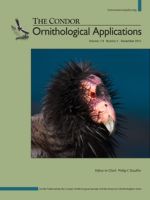Demographic and habitat preference studies are of paramount importance for conservation of birds, which is urgent in the mostly devastated Atlantic Forest. Moreover, these studies can indicate microhabitats that deserve more attention for conservation. In this article, we provide the first population density estimate and microhabitat preference assessment for the Southern Bristle-Tyrant (Phylloscartes eximius), a poorly known and threatened insectivorous bird endemic to the Atlantic Forest. The study was conducted at Cantareira State Park between May and December 2014. For density estimates we sampled 600 point counts using distance sampling, and for microhabitat assessment we compared 15 variables in 54 plots where birds were observed foraging with 145 random plots by adjusting generalized linear models and using hierarchical partitioning analysis. The species' density (12.7 [7.3–20.2] individuals per km2) is ∼1/16 the density of a globally threatened congener, the Restinga Tyrannulet (Phylloscartes kronei), and lower than most other small insectivorous passerines in Atlantic Forest. When alone or in pairs, Southern Bristle-Tyrants preferred forests within ∼10m of rivers and lakes; when in mixed-species flocks they preferred valleys (grotas). We suggest that protection of riverine forests would benefit Southern Bristle-Tyrants with positive consequences for the water supply of millions of people living in the Atlantic Forest domain.
How to translate text using browser tools
26 October 2016
Density and microhabitat preference of the Southern Bristle-Tyrant (Phylloscartes eximius): Conservation policy implications
Vinicius R. Tonetti,
Marco A. Pizo

The Condor
Vol. 118 • No. 4
November 2016
Vol. 118 • No. 4
November 2016
Atlantic forest
Brazil's Forest Code
distance sampling
hierarchical partitioning
Phylloscartes eximius
riverine vegetation




